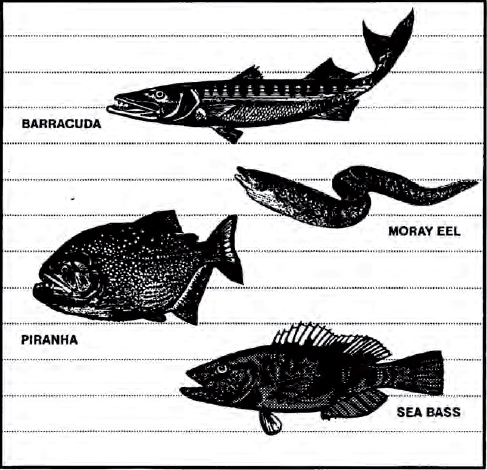Turtle
Be careful when handling and capturing large freshwater turtles, such as the snapping turtles and soft-shelled turtles of North America and the matamata and other turtles of South America. All of these turtles will bite in self-defense and can amputate fingers and toes.
Platypus
The platypus or duckbill (Ornithorhyncus anatinus) is the only member of its family and is easily recognized. It has a long body covered with grayish, short hair, a tail like a beaver, and a bill like a duck. Growing up to 60 centimeters in length, it may appear to be a good food source, but this egg-laying mammal, the only one in the world, is very dangerous. The male has a poisonous spur on each hind foot that can inflict intensely painful wounds. You find the platypus only in Australia, mainly along mud banks on waterways.
FISH THAT ATTACK MAN
The shark is usually the first fish that comes to mind when considering fish that attack man. Other fish also fall in this category, such as the barracuda, the moray eel, and the piranha.
Sharks
Whether you are in the water or in a boat or raft, you may see many types of sea life around you. Some may be more dangerous than others. Generally, sharks are the greatest danger to you. Other animals such as whales, porpoises, and stingrays may look dangerous, but really pose little threat in the open sea.
Of the many hundreds of shark species, only about 20 species are known to attack man. The most dangerous are the great white shark, the hammerhead, the make, and the tiger shark. Other sharks known to attack man include the gray, blue, lemon, sand, nurse, bull, and oceanic white tip sharks. See Figure 5-1 for illustrations of sharks. Consider any shark longer than 1 meter dangerous.

Figure 5-1: Sharks
There are sharks in all oceans and seas of the world. While many live and feed in the depths of the sea, others hunt near the surface. The sharks living near the surface are the ones you will most likely see. Their dorsal fins frequently project above the water. Sharks in the tropical and subtropical seas are far more aggressive than those in temperate waters.
All sharks are basically eating machines. Their normal diet is live animals of any type, and they will strike at injured or helpless animals. Sight, smell, or sound may guide them to their prey. Sharks have an acute sense of smell and the smell of blood in the water excites them. They are also very sensitive to any abnormal vibrations in the water. The struggles of a wounded animal or swimmer, underwater explosions, or even a fish struggling on a fish line will attract a shark.
Sharks can bite from almost any position; they do not have to turn on their side to bite. The jaws of some of the larger sharks are so far forward that they can bite floating objects easily without twisting to the side.
Sharks may hunt alone, but most reports of attacks cite more than one shark present. The smaller sharks tend to travel in schools and attack in mass. Whenever one of the sharks finds a victim, the other sharks will quickly join it. Sharks will eat a wounded shark as quickly as their prey.
Sharks feed at all hours of the day and night. Most reported shark contacts and attacks were during daylight, and many of these have been in the late afternoon. Some of the measures that you can take to protect yourself against sharks when you are in the water are—
• Stay with other swimmers. A group can maintain a 360-degree watch. A group can either frighten or fight off sharks better than one man.
• Always watch for sharks. Keep all your clothing on, to include your shoes. Historically, sharks have attacked the unclothed men in groups first, mainly in the feet. Clothing also protects against abrasions should the shark brush against you.
• Avoid urinating. If you must, only do so in small amounts. Let it dissipate between discharges. If you must defecate, do so in small amounts and throw it as far away from you as possible. Do the same if you must vomit.
If a shark attack is imminent while you are in the water, splash and yell just enough to keep the shark at bay. Sometimes yelling underwater or slapping the water repeatedly will scare the shark away. Conserve your strength for fighting in case the shark attacks.
If attacked, kick and strike the shark. Hit the shark on the gills or eyes if possible. If you hit the shark on the nose, you may injure your hand if it glances off and hits its teeth.
When you are in a raft and see sharks—
• Do not fish. If you have hooked a fish, let it go. Do not clean fish in the water.
• Do not throw garbage overboard.
• Do not let your arms, legs, or equipment hang in the water.
• Keep quiet and do not move around.
• Bury all dead as soon as possible. If there are many sharks in the area, conduct the burial at night.
When you are in a raft and a shark attack is imminent, hit the shark with anything you have, except your hands. You will do more damage to your hands than the shark. If you strike with an oar, be careful not to lose or break it.
If bitten by a shark, the most important measure for you to take is to stop the bleeding quickly. Blood in the water attracts sharks. Get yourself or the victim into a raft or to shore as soon as possible. If in the water, form a circle around the victim (if not alone), and stop the bleeding with a tourniquet.
Other Ferocious Fish
In salt water, other ferocious fish include the barracuda, sea bass, and moray eel (Figure 5-2). The sea bass is usually an open water fish. It is dangerous due to its large size. It can remove large pieces of flesh from a human. Barracudas and moray eels have been known to attack man and inflict vicious bites. Be careful of these two species when near reefs and in shallow water. Moray eels are very aggressive when disturbed.
VENOMOUS FISH AND INVERTEBRATES
There are several species of venomous fish and invertebrates, all of which live in salt water. All of these are capable of injecting poisonous venom through spines located in their fins, tentacles, or bites. Their venoms cause intense pain and are potentially fatal. If injured by one of these fish or invertebrates, treat the injury as for snakebite.

Figure 5-2: Ferocious fish

Figure 5-3: Stingray (Dasyatidae species)
Stingrays inhabit shallow water, especially in the tropics and in temperate regions as well. All have distinctive ray shape but coloration may make them hard to spot unless they are swimming. The venomous, barbed spines in their tails can cause severe or fatal injury. When moving about in shallow water, wear some form of footwear and shuffle your feet along the bottom, rather than picking up your feet and stepping.

Figure 5-4: Rabbitfish (Siganidae species)
Rabbitfish are found predominantly on reefs in the Pacific and Indian Oceans. They average about 30 centimeters long and have very sharp spines in their fins. The spines are venomous and can inflict intense pain. Rabbitfish are considered edible by native peoples where the fish are found, but deaths occur from careless handling. Seek other nonpoisonous fish to eat if possible.

Figure 5-5: Scorpion fish or Zebra fish (Scorpaenidae species)
Scorpion fish or Zebra fish live mainly in the reefs in the Pacific and Indian oceans, and occasionally in the Mediterranean and Aegean seas. They vary from 30 to 90 centimeters long, are unusually reddish in coloration, and have long, wavy fins and spines. They inflict an intensely painful sting.